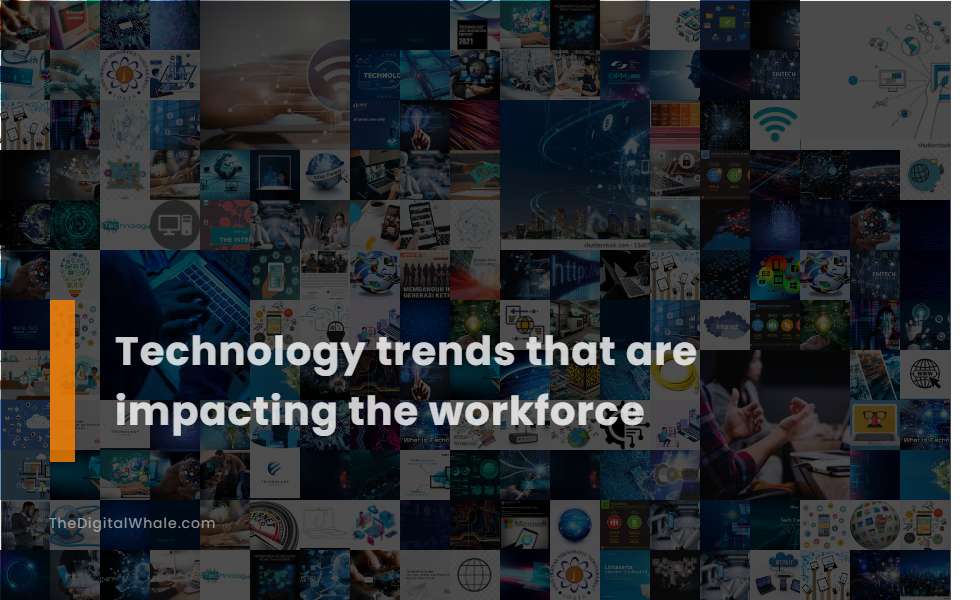Technology Trends That Are Impacting the Workforce
What is the average annual growth rate of the tech workforce in the United States? What impact is technology having on today's workforce? Let's find out more about Technology Trends That Are Impacting the Workforce.

Nearly all jobs require digital skills, with 92% of jobs demanding them, yet 33% of employees lack basic digital skills.
Nearly all jobs, with 92% requiring digital skills, highlight a significant gap as one-third of workers lack the foundational digital skills necessary for today's workforce, exacerbated by historic underinvestment and structural inequities. According to the National Skills Coalition, this gap underscores the urgent need for systemic change and investment in digital education across various sectors to ensure equitable access to these essential skills.
Automation, AI, and other technologies will disrupt 44% of workers' skills in the next 5 years.
By 2028, employers estimate that 44% of workers' skills will be disrupted due to rapid technological advancements, including automation and AI, which are reconfiguring job content and necessitating widespread upskilling and reskilling to maintain workforce relevance and efficiency. As highlighted by the Skills Gap Trends 2024, this shift underscores the pressing need for adaptable learning strategies in order to bridge the emerging skills gap and ensure that employees are adequately prepared for the evolving demands of the digital economy.
AI could impact 300 million jobs globally due to automation by 2030.
Artificial Intelligence (AI) is set to make a profound impact on the global job market, affecting approximately 300 million jobs worldwide due to automation by 2030. This technological evolution could potentially replace up to a quarter of all jobs in the U.S. and Europe. However, AI might not just be a harbinger of job displacement; it holds the promise of creating new job opportunities and significantly enhancing global productivity. To delve deeper into these transformative changes, you can explore more comprehensive insights on this topic at AI Affect Jobs.
Generative AI is affecting white-collar jobs, including roles in auditing and marketing.
Generative AI is anticipated to have a significant impact on white-collar jobs, influencing highly skilled roles in auditing, marketing, and other knowledge-centric fields by automating and augmenting various tasks. This technological advancement may lead to short-term layoffs but is expected to ultimately enhance productivity and transform job roles over the next decade. The Chicago Booth Review emphasizes that while generative AI targets tasks typically performed by educated white-collar workers, such as accountants and financial analysts, it holds the potential to replace lower-paying office support occupations and challenge more advanced tasks. However, it is believed that it will also enhance creative, STEM, and business-related work, offering a complex but transformative future for the labor market.
AI and automation will create new job opportunities, such as AI ethicist and machine learning engineer.
AI and automation are creating new job opportunities such as AI trainers and teachers, data analysts and scientists, human-machine teaming managers, and AI ethics and policy specialists, which require skills like critical thinking, creativity, and problem-solving. For more insights, visit the Innovative Pharma Education Blog to understand the profound influence on job roles, the workforce, and employment dynamics.
Related:
What is an overload in design? How do I ensure that all information is collected and curated for archival and historical purposes? Let's find out more about How To Manage Data and Information Overload.
The use of AI in HR is streamlining recruitment processes and improving employee retention analysis.
The use of AI in HR is streamlining recruitment processes by automating tasks such as candidate sourcing, screening, and scheduling, while also improving employee retention through data-driven decision-making and reducing biases in the hiring process. For more insights into this transformation, you can explore how AI and HR Technology Are Revolutionizing Recruitment and Hiring. By leveraging advanced technologies, HR professionals are able to optimize various aspects of recruitment, making the process more efficient and equitable.
Smart apps powered by AI are increasing labor efficiency and user satisfaction.
Smart apps powered by AI are increasing labor efficiency by automating repetitive tasks, enhancing decision-making, and improving work-life balance. These innovations are significantly impacting workforce dynamics and job roles, as they are outlined on Data Science Central. Moreover, AI is boosting user satisfaction through personalized experiences and reduced workload pressures, transforming the modern workplace in profound ways.
Industrial cloud platforms will be used by over 70% of enterprises by 2027 to accelerate business initiatives.
By 2027, over seventy percent of enterprises are anticipated to utilize Industry Cloud Platforms to propel their business initiatives, a significant increase from less than fifteen percent in 2023. This shift is attributed to ICPs' industry-tailored solutions, enriched data, and flexible architecture that elevate efficiency, productivity, and innovation. These platforms are becoming the cornerstone of strategic advancements, as highlighted in the article on the Next Frontier of Cloud Computing, which elucidates how businesses are leveraging cloud technology to maintain a competitive edge in the ever-evolving digital landscape.
Augmented Connected Workforce (ACWF) strategies are transforming collaboration and workforce analytics.
The Augmented Connected Workforce (ACWF) strategy is transforming collaboration and workforce analytics by leveraging smart connected worker platforms, AI, IoT, and other innovative technologies to enhance frontline workers' capabilities, productivity, and decision-making. This approach not only provides real-time guidance but also fosters a culture of continuous learning and innovation. For more insights, you can visit this Augmented Connected Workforce platform, which is at the forefront of these advancements, driving a new era of workforce enhancement.
Companies must invest in upskilling and reskilling employees to manage the transition to emerging technologies.
In today's rapidly evolving technological landscape, companies must prioritize upskilling and reskilling their employees to transition smoothly into utilizing emerging technologies like AI, machine learning, and robotic process automation. Such advancements create inevitable skills gaps, making some existing skills obsolete and demanding continuous learning for both maintenance of competitiveness and operational efficiency. By investing in employee development, businesses not only enhance skill sets but also improve retention rates and reduce the cost attached to hiring new talent. This strategic focus ensures that employees are well-equipped to effectively consume and leverage new technologies, propelling business innovation and growth. The importance of this approach is further emphasized by insights on Emerging Technologies, highlighting the necessity for organizations to embrace continuous learning and skill enhancement to thrive in a competitively evolving market.
Related:
What are the possible solutions to the information technology (IT) problem? What are the benefits of using information technology to improve your business? Let's find out more about The Future of Information and Technology.
